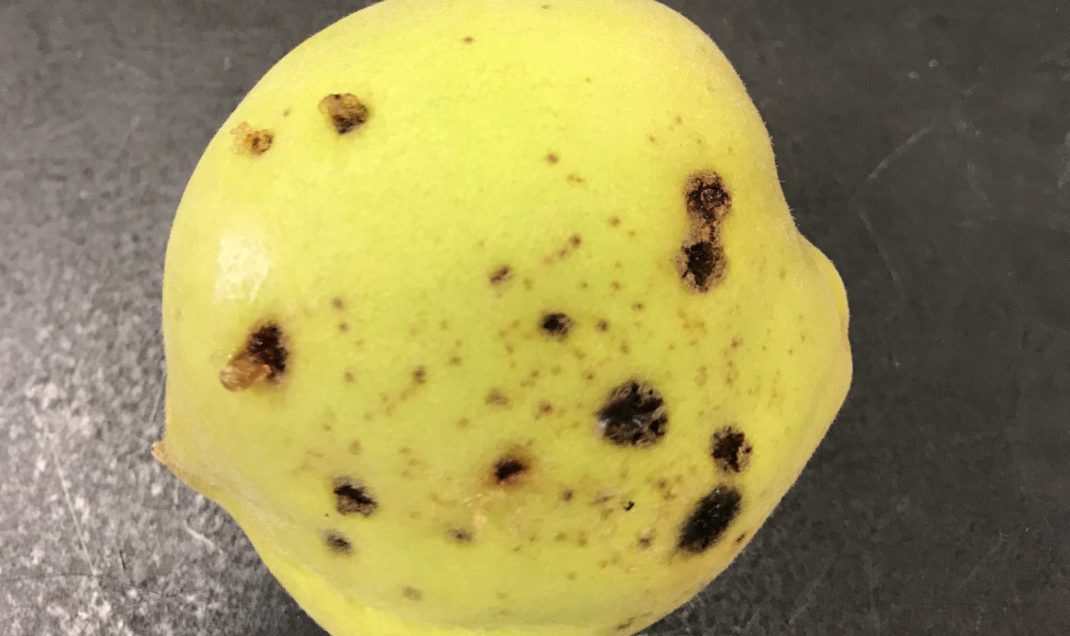CLEMSON – Bacterial spot has threatened South Carolina peaches for as long as anyone can remember, but a Clemson University student is hoping his research can bring some relief to the peach industry.

Brodie Cox, a master’s student in plant and environmental sciences from Aiken, is focusing his studies on bacterial spot caused by Xanthomonas arboricola pv. pruni. (Xap).
“Bacterial spot is tough to control,” Cox said. “Once this disease makes its way to a field, it’s there for the life of the orchard.
Bacterial spot is a major disease in peaches. Symptoms on green fruit include water-soaked lesions, while symptoms on maturing fruit vary from light speckles to deep crater lesions. Leaves also are affected and show yellowing starting at the tip end. Severe leaf infections can cause early defoliation resulting in reduced fruit size, sunburn and cracking.
Cox’s major professor, Clemson plant pathologist Guido Schnabel, said the fight against bacterial spot is a constant battle.
“Growers spray for this disease all of the time,” said Schnabel who also is a member of the Clemson Cooperative Extension Service Peach Team. “But we still cannot effectively manage bacterial spot.”

The study focuses on determining where the bacteria overwinter and how they adapt to chemical exposure. Cox collected tissue samples from four South Carolina peach farms three times during the growing season – in early spring, late spring and 2 weeks prior to harvest in mid/late summer – to capture a picture of the bacteria’s sensitivity to chemicals throughout the growing season. He then applied a petri dish-based assay to test common control compounds such as copper and oxytetracycline. Repeated applications typically are necessary for even minimal disease control.
“We compared common control methods to try and get a better idea of what can be done to better control bacterial spot,” Cox said.
Hehe Wang, a Clemson plant bacteriologist, said the bacteria is difficult to control because most commercial peaches are susceptible and the limited number of disease-tolerant/resistant cultivars also could develop symptoms during high-infection periods. In addition, there are no cultural controls available and chemical control options are limited.
“The current disease management mainly relies on weekly spray of copper and antibiotics, such as oxytetracycline, throughout the growing season,” Wang said. “But the disease incidence is still high when weather conditions are conducive. The disease pressure in the past few years has been high and it has raised concern about the development of chemical resistance in the Xap population.”
The disease is more apt to occur during warm, wet spring weather. Information from the National Oceanic and Atmospheric Administration North Carolina Institute for Climate Studies shows the average temperature for South Carolina has increased about 0.5 degrees since the early 20th century. Historically unprecedented warming, including extreme heat events, is projected by the end of the 21st century. Figures from the NOAA National Centers for Environmental Information show South Carolina spring temperatures and rainfall amounts have been above average for the past several years.
Peaches are a driving force in the South Carolina economy and if temperatures and precipitation continue to increase during spring months when peaches are growing, the state’s agricultural economy could be hit hard. According to the United States Department of Agriculture, South Carolina is second to California in peach production. In 2018, South Carolina growers produced 65,800 tons of peaches for a production value of about $72 million. California produced 479,000 tons of peaches and Georgia came in third with 26,000 tons of peaches produced.
Cox earned his bachelor’s degree in plant and environmental sciences from Clemson in 2018. He plans to graduate with his master’s degree in 2020. While he may not have a definite fix for bacterial spot of peach by then, Cox said he hopes to gain a better understanding of the disease so that he can help South Carolina growers produce better peaches.
“I grew up close to major peach growers and I’ve always had a heart for peaches,” Cox said. “Studying at Clemson has helped me understand Cooperative Extension research and how vital that research is for the agricultural industry. While in undergraduate school, we were challenged to think critically and learn how to apply our knowledge to the world around us. My work experience in the lab and in the field while at Clemson has helped me understand how to move discoveries from the lab to the field in order to make an impact on the industry. Working alongside Dr. Schnabel with local growers has helped me communicate and work with growers in the industry. I want to continue to do what I can to help the South Carolina agricultural industry.”
-END-
Get in touch and we will connect you with the author or another expert.
Or email us at news@clemson.edu

